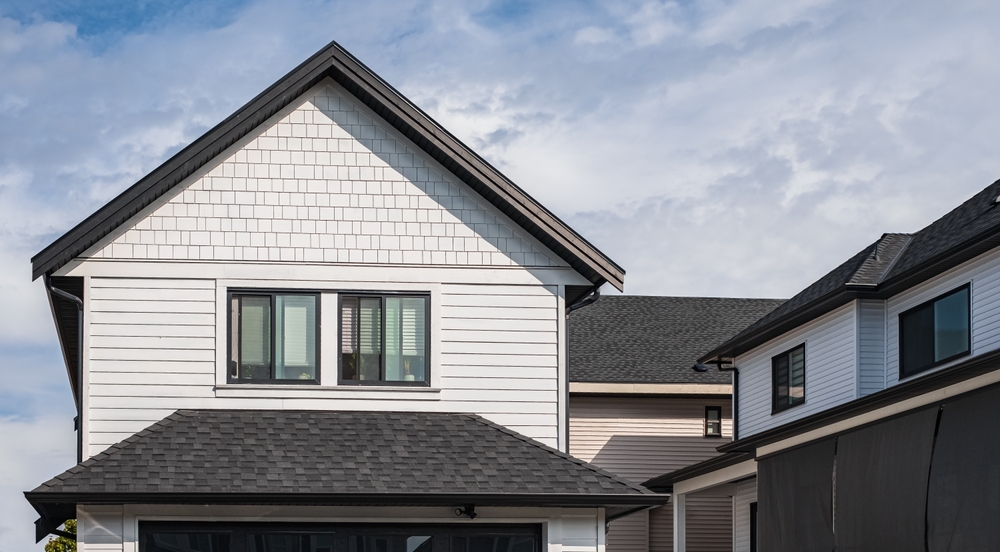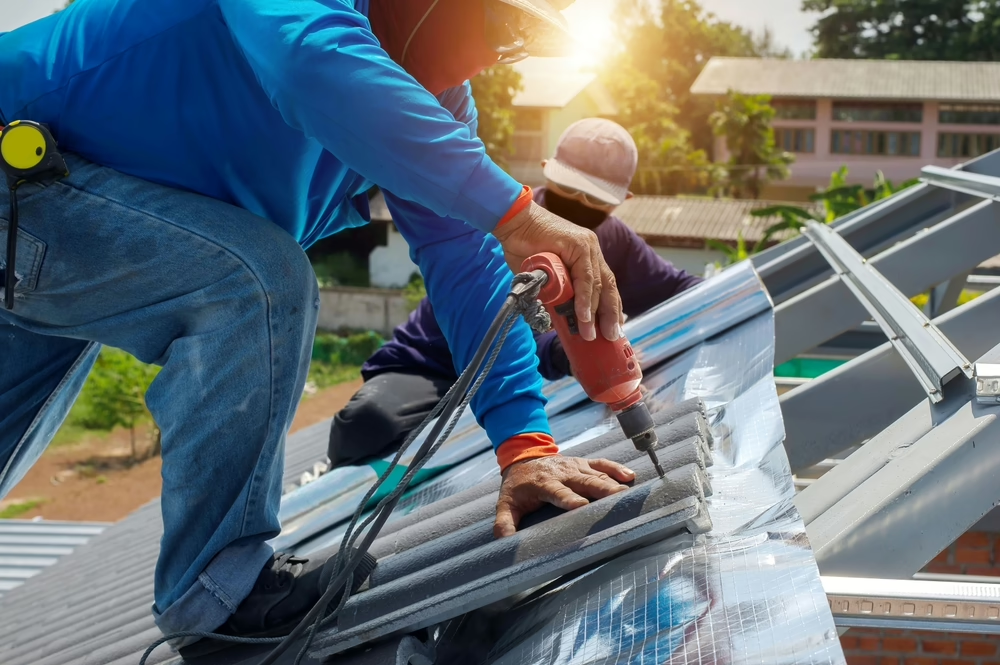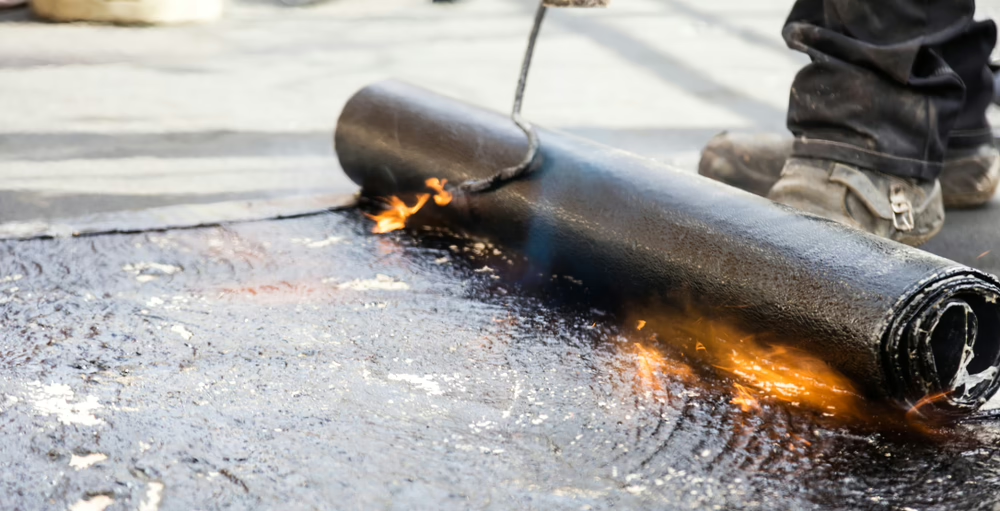What if every decision you make about replacing your commercial roof could either keep your business humming along smoothly or grind operations to a frustrating halt? The stakes feel impossibly high when you’re balancing customer satisfaction, employee productivity, inventory protection, and revenue generation against the very real need to fix what’s literally over everyone’s heads.
For business owners and property managers facing a commercial roof replacement, the project itself isn’t the only challenge. The real test is keeping your doors open, your team working, and your customers happy while thousands of square feet of roofing material gets stripped away and rebuilt above the daily chaos of commerce.
Commercial roof replacement isn’t like swapping out a residential roof on a quiet Sunday afternoon. Your building houses machinery, inventory, employees, and customers who all expect normal operations. The noise alone can interrupt phone calls and meetings. Debris presents safety hazards. Weather exposure threatens temperature-sensitive products. Access limitations can block deliveries. Every complication multiplies when you consider that most businesses simply cannot afford to close for weeks while contractors work overhead.
The good news is that disruption doesn’t have to be inevitable. With proper planning, clear communication, and an experienced roofing contractor who understands operational needs, most businesses continue functioning throughout the replacement process. Martin Roofing & Construction has spent years perfecting strategies that protect business continuity while delivering the quality roof your building deserves. The key lies in understanding what happens during each phase and planning around the realities of your specific operation.
Understanding the Commercial Roof Replacement Process
Before you can minimize disruption, you need to understand what you’re working with. Commercial roof replacement typically involves several distinct phases, each presenting its own operational challenges:
- Preparation and planning (establishing work zones and access points)
- Tear-off and disposal (the most disruptive phase with noise and debris)
- Deck inspection and repair (where hidden problems often emerge)
- New roof installation (weather-dependent and timing-sensitive)
- Cleanup and final inspection (restoring normal building operations)
The tear-off phase creates the most dramatic disruption. This is when crews remove the existing roofing material, exposing the deck beneath. Depending on your roof system (whether it’s built-up roofing, modified bitumen, TPO, EPDM, or another membrane system), this process generates noise, vibration, and debris. Workers will be walking overhead, equipment may create vibrations that travel through the building structure, and there’s always the question of weather protection if rain threatens during an exposed period.
Deck inspection follows tear-off, and this phase often reveals surprises. Water damage, structural deterioration, or inadequate insulation become visible only after the old roof comes off. These discoveries can extend timelines and require additional work, which is why experienced contractors like Martin Roofing & Construction build flexibility into project schedules. Finding problems early prevents catastrophic failures later, but it does mean adjusting expectations about completion dates.
The installation phase brings its own set of considerations. New roofing systems require specific conditions for proper application. Temperature ranges matter for adhesives and sealants. Wind conditions affect membrane installation. Humidity impacts curing times. Your contractor needs to balance ideal installation conditions against your operational needs, sometimes working in shorter bursts or adjusting daily schedules to accommodate business requirements.
Pre-Project Planning That Makes the Difference
The disruption-minimization process actually begins weeks before the first crew member sets foot on your roof. Detailed pre-project planning separates smooth replacements from operational nightmares. Start by conducting a thorough walk-through of your facility with your roofing contractor. Point out sensitive areas: server rooms, manufacturing equipment vulnerable to vibration, inventory susceptible to temperature changes, customer-facing spaces where noise matters most.
Document everything about your operational schedule. When do deliveries arrive? What are your busiest customer hours? Do you have any processes that require climate control or minimal vibration? Are there times when noise restrictions matter more than others? This information allows contractors to schedule disruptive activities during your slowest periods:
- Retail businesses might prefer roof work before store opening hours
- Restaurants could schedule the noisiest phases between lunch and dinner service
- Office buildings might push heavy work to weekends
- Manufacturing facilities can coordinate around production shift changes
Establish clear communication protocols before work begins. Designate a point person from your organization who can make real-time decisions when unexpected situations arise. Your roofing contractor should assign a project manager who remains accessible throughout the job. Exchange contact information, preferred communication methods, and expected response times. Nothing derails a project faster than inability to reach decision-makers when questions arise.
Create contingency plans for weather delays and unexpected discoveries. What happens if rain forces a temporary stop? Where will workers stage materials if the original plan doesn’t work? How will you handle extended timelines if significant deck damage appears? Having answers ready prevents scrambling when circumstances change.
Protecting Your Interior Operations
Once work begins, protecting the interior becomes paramount. Professional contractors use multiple strategies to shield your business from overhead activities:
- Tarping and weatherproofing systems provide immediate protection if rain threatens during an exposed period
- Dust and debris control through containment barriers and designated waste removal chutes keeps customer areas presentable
- Vibration management protects sensitive equipment like servers, laboratory instruments, and manufacturing machinery
- Temperature control coordination with your HVAC team maintains comfortable conditions despite roof exposure
Martin Roofing & Construction’s teams carry emergency weather protection materials and can quickly secure vulnerable areas if forecasts change unexpectedly.
Scheduling Strategies for Continued Operations
Strategic scheduling transforms potential chaos into manageable inconvenience. Phased installation allows portions of your building to remain fully operational while work progresses elsewhere. Instead of tackling the entire roof simultaneously, contractors section the project into manageable zones. This approach extends the overall timeline but dramatically reduces disruption at any given moment.
After-hours and weekend work eliminates conflict with peak business periods. Many commercial projects benefit from scheduling disruptive activities outside normal operating hours. Yes, this often increases labor costs because of premium pay rates, but the tradeoff preserves revenue generation and customer experience. A busy medical office might schedule tear-off for evenings and weekends, while a 24/7 manufacturing facility might identify brief slowdown periods for intensive work phases.
Weather-dependent flexibility helps maintain schedules without compromising quality. Experienced contractors monitor forecasts constantly and adjust plans accordingly. If rain threatens on Tuesday but Wednesday looks clear, shifting the tear-off schedule protects both the building and the business operations. This flexibility requires open communication and trust between property managers and contractors.
Coordination with other building systems prevents conflicts and complications. If you’re planning HVAC maintenance, elevator inspections, or other building work, coordinate those schedules with the roof replacement. Some activities complement each other (like accessing HVAC equipment during roof work), while others create conflicts that should be avoided (like painting projects during dusty tear-off phases).
Communication Plans That Keep Everyone Informed
Effective communication might be the single most important disruption-minimization tool. Your employees need advance notice about noise, parking changes, restricted access areas, and potential impacts on their workspaces. A simple weekly update email or morning huddle announcement keeps staff informed and reduces surprise and frustration.
Customer communication prevents confusion and demonstrates professionalism. For retail businesses, simple signage explaining temporary noise or appearance changes shows customers you’re investing in the facility. Restaurants might include a brief note on menus. Professional offices can mention ongoing improvements when greeting clients. Proactive communication turns potential complaints into opportunities to showcase facility investment.
Tenant notification in multi-tenant buildings requires special attention. If you manage a commercial property with multiple businesses, each tenant experiences the roof replacement differently depending on their location and business type. Individual meetings, written notices, and regular updates help tenants plan around the project and feel included in the process.
Daily briefings between contractors and facility managers create feedback loops that catch problems early. A quick morning meeting reviews the day’s planned activities, weather considerations, and any overnight developments. An end-of-day check-in confirms completed work, addresses any issues, and previews the next day’s schedule.
Managing Specific Operational Challenges
Different business types face unique challenges during commercial roof replacement. Understanding these specific concerns helps develop targeted solutions. Retail operations worry most about customer experience and merchandise protection. Positioning work away from main entrances during peak shopping hours, using quieter equipment during business hours, and ensuring parking access remains clear all contribute to minimal customer impact.
Food service establishments face health code considerations and customer comfort issues. Coordination with health inspectors, extra attention to cleanliness, potential temporary closure of outdoor seating areas, and careful scheduling around meal service times all factor into successful projects. Some jurisdictions require health department notification before beginning roof work over food preparation or service areas.
Manufacturing facilities need to protect production equipment and maintain output schedules. Vibration-sensitive machinery might require production schedule adjustments. Dust-sensitive processes may need additional containment barriers. Some manufacturing operations can shift production to different building areas during particularly disruptive phases, maintaining output while protecting equipment.
Medical and dental offices cannot compromise patient care or safety. Scheduling around patient appointments, ensuring emergency access routes remain clear, maintaining proper HVAC function for exam rooms, and minimizing noise during procedures all require careful planning. Some medical facilities prefer completing roof work during holiday weeks or traditional vacation periods when patient volumes naturally decrease.
Office buildings deal primarily with noise disruption to meetings, phone calls, and concentration-dependent work. Scheduling heavy demolition outside core business hours, providing advance notice of particularly noisy days, and potentially offering remote work options for employees in directly affected areas all help maintain productivity.
Safety Protocols That Protect Everyone
Safety extends beyond protecting your roof workers. Comprehensive safety planning protects employees, customers, and the general public throughout the project:
- Restricted access zones with clear signage and physical barriers keep unauthorized people away from dangerous areas
- Parking and traffic flow management designates contractor vehicle areas while maintaining clear pedestrian pathways
- Debris containment systems prevent material from falling onto occupied areas or parked vehicles
- Emergency procedures ensure everyone knows evacuation routes and contact protocols if something goes wrong
Professional contractors like Martin Roofing & Construction use catch systems, barriers, and careful material handling protocols to ensure nothing unexpected drops from the roof.
Timeline Expectations and Milestone Planning
Understanding realistic timelines prevents frustration and allows proper operational planning. Commercial roof repair in Warminster doesn’t always come with set timelines. The duration varies based on building size, roof complexity, weather conditions, and the specific roofing system being installed. A straightforward TPO or EPDM replacement on a 10,000 square foot building might complete in one to two weeks under good conditions. Larger buildings, complex designs, or projects revealing significant deck damage extend timelines accordingly.
| Project Phase | Typical Duration | Disruption Level | Planning Considerations |
| Initial Inspection & Planning | 1-2 weeks before start | Minimal | Schedule access for detailed measurements |
| Material Delivery & Staging | 1-2 days | Low | Designate parking/staging areas |
| Tear-off & Removal | 2-5 days | High | Peak noise and vibration period |
| Deck Inspection & Repairs | 1-3 days | Medium | Potential timeline extension if issues found |
| New Roof Installation | 3-10 days | Medium | Weather-dependent scheduling critical |
| Final Inspection & Cleanup | 1-2 days | Low | Coordinate for final walk-through |
Milestone communication keeps stakeholders informed without overwhelming them with daily details. Setting expectations around major completion points (tear-off complete, new membrane installed, final inspection passed) provides checkpoints for everyone involved.
Buffer time in schedules accommodates weather delays, unexpected repairs, or material delivery issues without derailing your operational planning. Experienced contractors build contingency time into estimates rather than promising unrealistic completion dates that create false expectations.
Working With the Right Contractor
Contractor selection significantly impacts disruption levels. Experience with commercial projects specifically matters because commercial work differs substantially from residential roofing. Martin Roofing & Construction brings expertise in managing occupied buildings, understanding operational needs, and balancing project efficiency with business continuity.
Look for contractors who ask detailed questions about your operations during the estimate phase. Key qualities include:
- Detailed questions about your business operations and busiest periods
- Willingness to schedule around your operational needs
- References from similar commercial projects
- Clear communication protocols and designated project managers
- Comprehensive insurance and warranty coverage
References from similar businesses provide insight into real-world performance. Ask potential contractors for references from comparable operations. A contractor successful with retail centers might approach projects differently than one experienced with manufacturing facilities. Speaking with property managers or business owners who’ve navigated similar projects reveals how contractors actually perform when challenges arise.
Clear contracts protect everyone involved. Detailed agreements should specify work hours, noise restrictions, cleanup protocols, communication expectations, and procedures for handling unexpected discoveries. Written clarity prevents misunderstandings and provides recourse if expectations aren’t met.
Cost Considerations of Disruption Mitigation
Minimizing disruption sometimes increases project costs, but the investment usually proves worthwhile. After-hours labor typically costs 15 to 25 percent more than standard daytime rates. Phased installations may extend overall timelines and supervision costs. Enhanced protection measures, additional cleanup protocols, and specialized scheduling all add incremental expenses.
However, these costs often pale compared to lost revenue from business closures or decreased customer satisfaction. A restaurant that closes for a week during roof replacement loses immediate revenue and risks losing regular customers who find alternative dining options. A retail store that suffers reduced foot traffic because of construction disruption may never fully recover lost sales. Office productivity losses from distraction and discomfort affect long-term business performance in ways that exceed premium labor rates for evening and weekend work.
Calculate your actual cost of disruption when evaluating contractor proposals. What does an hour of closed business cost you? How much revenue do you lose when customer experience suffers? What productivity decreases when employees work in noisy, uncomfortable conditions? These calculations often justify paying modestly more for a contractor who prioritizes operational continuity.
Insurance and warranty considerations also factor into decisions. Working with established, fully insured contractors like Martin Roofing & Construction protects against liability if accidents occur. Comprehensive warranties on materials and workmanship protect your investment long after the project completes. Choosing contractors based solely on lowest bid can backfire spectacularly if problems arise during or after installation.
Post-Project Follow-Up and Maintenance
The project doesn’t truly end when the last worker leaves your roof. Final inspections verify proper installation and identify any outstanding details. Walk the entire roof with your contractor, checking seams, flashing, penetrations, and drainage. Inside the building, inspect ceilings, HVAC systems, and any areas that were particularly sensitive during construction.
Documentation of completed work provides valuable records for future maintenance and warranty claims. Collect material specifications, warranty information, manufacturer certifications, and as-built drawings showing roof layout and details. This documentation proves essential years later when planning maintenance or addressing any issues.
Maintenance planning extends your new roof’s lifespan and protects your investment. Establish regular inspection schedules, drainage system cleaning protocols, and proactive repair procedures. Many commercial roofing problems start small and grow into expensive disasters when ignored. Catching issues early during routine maintenance prevents premature failure and protects business operations from emergency repair disruptions.
Making It Work for Your Business
Commercial roof repair in Newtown represents a significant investment in your facility and a substantial operational challenge. The difference between a nightmare scenario and a manageable inconvenience lies in planning, communication, and working with contractors who understand that your business cannot simply pause while work happens overhead.
Martin Roofing & Construction approaches commercial projects with operational continuity as a primary goal alongside quality installation. Their experience working with occupied buildings throughout the region means they’ve encountered virtually every challenge that can arise and developed proven strategies for addressing them. Whether your business operates retail hours, runs 24/7 manufacturing, serves patients and clients, or houses office workers, experienced contractors adapt their approach to your specific needs.
The roof over your business does more than keep rain out. It protects your inventory, your equipment, your employees, and your customers. When that roof needs replacement, the project itself shouldn’t threaten the very things the roof exists to protect. With proper planning, clear communication, strategic scheduling, and an experienced contractor who values your operational needs, you can get the quality roof your building deserves without sacrificing the business success that building supports.
We know that your business cannot afford unnecessary downtime, but it also cannot afford a failing roof. The solution isn’t choosing between operational continuity and necessary roof replacement. The solution is finding contractors who understand that both goals matter equally and who bring the experience, flexibility, and commitment necessary to achieve them simultaneously. That’s the difference between a roof replacement project you dread and one you navigate successfully while keeping your doors open and your business thriving. Contact Martin Roofing and Construction today to avoid missing a beat in your day-to-day operations.


